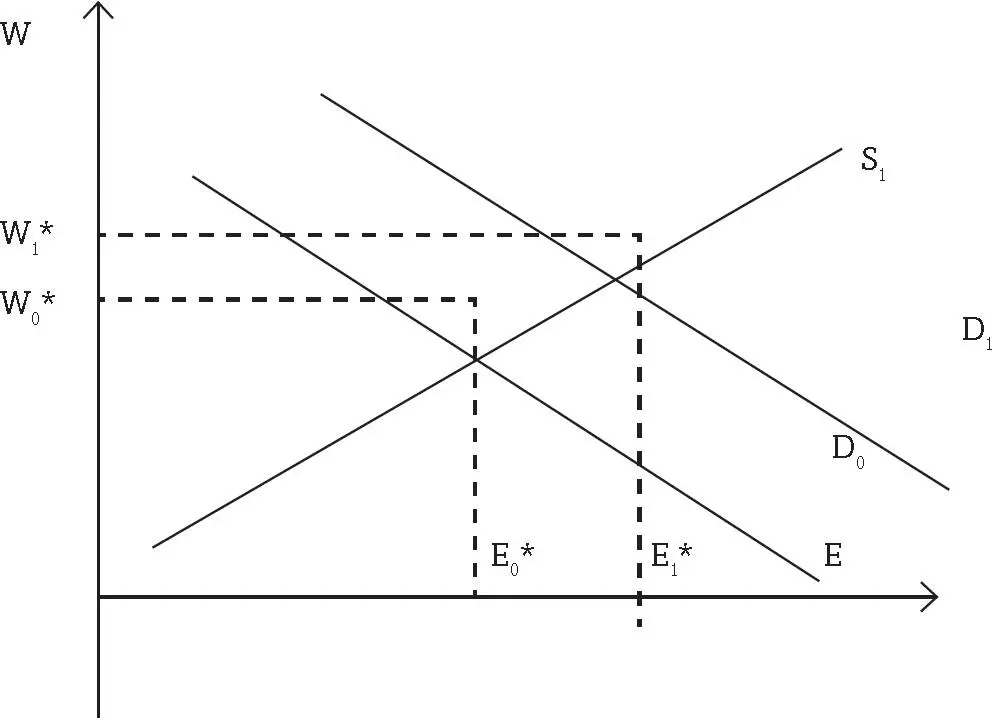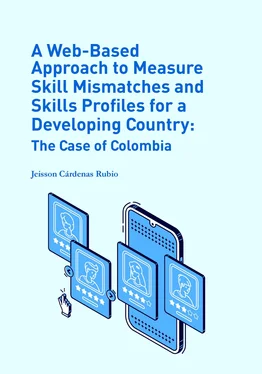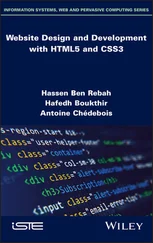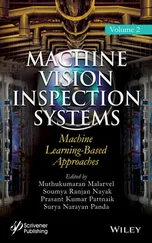1 ...8 9 10 12 13 14 ...20 2.3.1. Labour demand
The labour market works under perfect competition when employers and workers are perfectly informed about the quality (e.g. job requirements, localisation of job opportunities, etc.) and price of “labour” (e.g. wages), all agents are price-takers (which means that there are no monopolistic/monopsonistic powers), and there is perfect human rationality (all agents are capable of analysing all possible economic decisions and outcomes, and choosing the path that maximises their utility or profits) (Cahuc, Carcillo, and Zylberberg, 2014; Sen 1977). Given these assumptions, what defines a labour market can be expressed as follows.
On one side, picture a representative firm, which produces goods and services by using two inputs, Labour (L) and Capital (K), at a certain technology level. Consequently, the production function (F) of this representative firm is given by:
Y = F(L,K)
where Y denotes the physical output of the firm and pY is its value-added form, where p is the market price of the product. The cost of labour used in the production takes the form of wages and other on-costs, such as national insurance (the price per hour of hiring a unit of labour services), while the cost of capital is the price of renting a unit of capital. 17
In the short run, when capital is fixed, the marginal product of labour falls as the number of employed individuals rises. The initial condition for employing anyone at all is that the value of the marginal product of the first worker exceeds their going wage; if so, the firm expands its number of employees until the marginal return to the last unit of that labour equals the marginal wage (cost of labour):
p F’ (L) = w
On the other side, there are a large number of workers who offer a certain quantity of labour and will receive a wage if they are hired.
2.3.2. Labour supply
The utility function of a representative worker is composed of two parameters: income (R), 18which is equal to their wage (times the number of hours worked if the worker is hired, and zero if the worker is not hired), 19and the individual’s leisure time (the number of hours not spent at work). There is decreasing marginal utility of income (which is spent on goods and services or saved) and leisure time; thus, the line in the utility function for combinations of income and leisure to yield a given level of utility (i.e. an indifference curve) is convex to the origin (zero income and leisure). Indifference curves further from the origin are associated with higher levels of utility.
2.3.3. Market equilibrium
An equilibrium in the market is achieved where the upward sloping labour supply curve cuts (in other words, it equals) the downward sloping labour demand curve at a certain level of wages (w*) (labour supply equals demand). Only individuals whose reservation wage (θ) (reflecting their disutility of work) is greater than the equilibrium wage do not participate in the labour market (inactive). In a perfect competition model, as there is perfect information in terms of labour supply and demand, all individuals who wish to participate in the labour market (θ ≤ w*) will find a job, and firms will find a worker to fill their vacancies.
The model does not explicitly talk about the role of skills in the labour market; yet it is relatively easy to incorporate this aspect into this labour market model. As mentioned above in Section 2.2, Mincer (1958) and Becker (1962) introduced the idea that education is an investment in the economic model. Thus, education makes an individual more productive and might create wage differentials.
To be more specific, if people know the relevant characteristics of each job (perfect information), they can choose a general level of training (i) that will increase their production function: y(i). Firms will demand workers with a certain level of training (i) until the marginal benefit of using one unit of that labour equals the marginal wage: w(i). Consequently, the wage of a worker, w(i), will be a function of the level of qualification, all other things being equal, and the possibility of a higher wage acts as an incentive for training. Thus, individuals will train until the marginal cost of training equals the marginal return of this investment. Once more, under the assumptions of perfect competition, an equilibrium is reached when labour demand equals labour supply, and all individuals who wish to participate (θi ≤ wi*) will find a job.
Therefore, one of the most remarkable results from this model is that under perfect competition there is no structural unemployment, instead all workers receive a wage (w*) at their level of employment (E*) ( Figure 2.3). Nevertheless, there is a possibility that unforeseen impacts on the supply of labour might create disequilibrium in the short run (Bosworth, Dawkins, and Stromback, 1996, p. 200). For instance, as shown in Figure 2.3, improvements in technologies such as computers might increase the demand for people who know how to use that technology (from D 0to D 1), and, consequently, wages will rise from W 0to W 1. This situation might create a scarcity (E 1*-E 0*) of those people for a period. However, as all agents are (somehow) well informed, workers will start offering labour according to employer requirements.
Figure 2.3. Labour market equilibrium under perfect competition

Source: Author’s elaboration.
When job seekers know the job requirements (skills, experience, occupational requirements, etc.) and the localisation of job opportunities (cities, companies, etc.), they will train and search in the proper places where vacancies are available. Moreover, as employers know the characteristics of job applicants (e.g. skills), they will hire people who match their job requirements. Additionally, education and training providers (as any other firm) will have all the relevant information to create and adjust their curriculum contents according to employer requirements. 20Thus, people will find a job according to their characteristics (skills) and employers will find workers according to their requirements. Hence, unemployment rate remains comparatively low under perfect competition and there are no barriers that force a worker to work involuntarily in the informal economy.
According to the perfect competition model, people make optimal decisions based on the options (information) available to them. Thus, the perfect information assumption is a key element for the well-functioning of the labour market because it helps people to choose the option that maximises their utility or profit. When there are information problems, even fully rational agents in a non-monopolistic labour market might not know the option that could provide the maximum utility/profit. In the labour market, this information problem means, for instance, that job seekers and training centres might not know what skills are being demanded. Some people might acquire the “wrong” skills according to labour demand. Consequently, there will be people with certain skills who are excluded from the formal economy because their skills are not being demanded, and there will be unfilled vacancies because there are no people with the proper skills.
2.4. Market imperfections and segmentation
To develop the above ideas, Section 4 explains how imperfect information (e.g. labour market failures) might increase skill mismatching and, consequently, might create labour market segmentation between formal and informal workers along with a comparatively high unemployment rate.
2.4.1. Segmentation
The above assumptions about perfect information (defined in Section 2.3), where all agents in the model are price-takers and rational, are too simplistic (Garibaldi 2006). An extended literature review has shown that the high incidence of informality in countries like Colombia can be due to labour market segmentation (Doeringer and Piore 1971; Reich, Gordon, and Edwards 1973) (see Chapter 3). Specifically, barriers might exclude some workers from the comparatively high-productive sector (e.g. formal sector) and drive those excluded individuals to a more disadvantaged sector, such as the informal market (Piore 1972; Gambin et al. 2016; Palmer 2018).
Читать дальше













